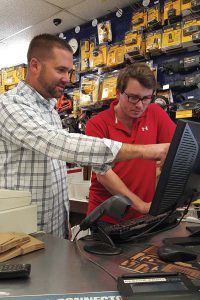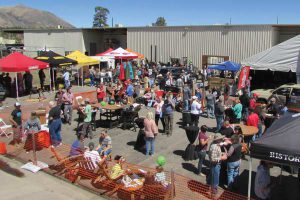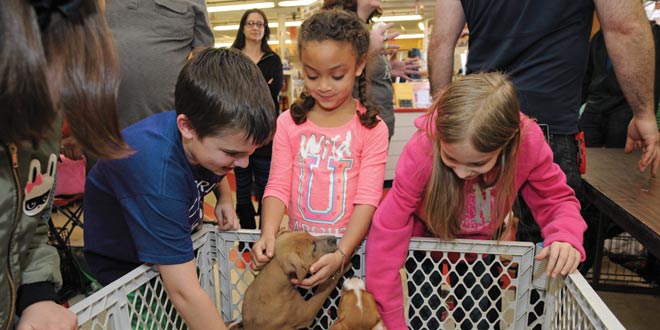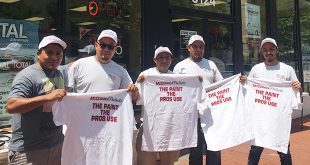To download a PDF of this story click here. Also, while this story is jam-packed with information, there is some retailer stories we were not able to fit in. Visit the links below to get additional stories and ideas on the following topics.
- Community Events
- Beyond the Typical Donation
- Holding Leadership Positions
- Connecting With Generations
- Partnering With the Local Community
Stand Up Stand Out.
By Renee Changnon rchangnon@nrha.org, Sara Logel slogel@nrha.org and Hilary Welter hwelter@nrha.org
It was noon on a Saturday, and crowds of people were walking shoulder-to-shoulder into Keck Hardware and Hobby with one thing on their minds—adopting a pet.
Instead of answering questions about home improvement projects, store owner Tom Klaus was guiding animal shelter volunteers to areas where animals could be petted and played with, while guests walked around the store, gawking at dogs, cats, a litter of puppies and even some rabbits.
Klaus started this biannual event a few years ago and even found his own dog, Anya, at the second event he hosted. Anya now has a permanent role on the Keck Hardware team and comes to work every day, which is even further proof that for Klaus, his animal adoption days are more than just events.
Whether interacting with customers in his store on a typical day or during a busy pet adoption event, it’s clear Klaus is an animal lover and has found his passion.
“I think, as a small business owner, having good merchandise and top-notch customer service is great, but your self image is just as important as your inventory,” he says. “When your customers know you care about them, they’ll want to return to your business and give back.”
To discover how retailers are building and nurturing these kinds of bonds with their communities, we spoke with retailers in the U.S. and Canada.
Their stories may inspire you to expand your community outreach and prompt you to get more involved in your own town.
The five ways the retailers we spoke with are helping others include: hosting community events for a cause, going beyond monetary donations, becoming involved in the local government, mentoring and providing internships for kids and young adults and supporting other independent businesses.
“A caring store attracts like-minded customers who care about the community,” says John Locke, owner of Orillia Home Hardware Building Centre in Orillia, Ontario.
“We don’t mind giving because our community gives back,” he says. “People tell us they shop here because we care.”
Store Events Unite the Community
One of the best ways to connect with your community is by hosting in-store events, especially those that give back to a cause within your town.
If executed well, a good event will cause a buzz among your customers and their friends who may have never heard of your business before. By hosting events like a pet adoption day or a ladies’ night, your business can help unite community members and ultimately show how much you care.
Events Make an Impression
Twice a year, Klaus begins the task of reaching out to local animal shelters to participate in the Pet Adoption Day event he hosts in his Trenton, Michigan, store. He’ll call animal shelters in the surrounding area and see if they have any volunteers willing to bring in adoptable pets at a future event.
Now in its eighth run, the event has grown, and the word has spread. Community members now associate Keck Hardware with more than just its plumbing and hobby departments. They associate the store with kindhearted employees who want to help animals find a home.

Each Pet Adoption Day takes extra time and effort, as Klaus begins planning about two months prior. First he reaches out to local shelters and sets up the date. Then, a week leading up to the event, he’ll call the shelters to get a head count of how many animals he can expect. This ranges from 10 to more than 20 animals, which people can come visit for about four hours.
His employees help him take down key aisles in the store to make room for the extra visitors, and after the event ends, it’s time to clean up and get the store back in order.
With crowds upward of 200 attendees at the past few events, most of the animals brought in have found their forever homes, and along the way, Klaus and the business have been able to raise money and awareness for local shelters. To Klaus, the events make a bigger impact than simply sending a check.
“Donating money is always good, but when you actually see your time and effort come together, like a family adopt a dog or a family member who lost someone find a new pet, it’s a great feeling,” he says. “To be a part of something like that feels great, and my hope is that through word of mouth, people have a positive image of our business.”
For Klaus, this event, along with a host of other events throughout the year, are wonderful opportunities to stay connected to the community and help local causes.
Leading up to and during the pet adoption events, Klaus holds a charity drive, selling bags of candy for kids as well as dog and cat treats. All of the proceeds from these sales go to the shelters Keck Hardware partners with.
To learn more about what Klaus does before, during and after a Pet Adoption Day event, visit TheRedT.com/PetAdoption. In this video, Klaus shares how he successfully executes the event.
Then, for a basic rundown of how to plan and execute any event, visit TheRedT.com/EventGuide to print out a helpful PDF Event Guide.
To read more about community events other retailers host visit, TheRedT.com/CommunityEvents.
Looking Beyond the Typical Donation
Receiving requests for donations is a regular occurrence for many business owners.
While it isn’t a bad idea to write a check to a deserving cause, this store finds ways to help beyond a monetary donation, which ultimately gets community members involved with the business and creates more customer engagement and awareness.
Providing for a Community Need
“As a store, we believe no one should go hungry, especially a child,” says Locke.
Stamp Out Hunger is Orillia Home Hardware Building Centre’s movement to end hunger in Orilia, Ontario. This movement includes a variety of events and store initiatives.
“One thing we do is help our customers understand that our store donates money and food, but customers can also take a bag of top soil that costs $2, cut the top off the bag, stand it up anywhere, put a tomato plant in it and grow food,” Locke says. “From a simple bag of soil, you can create your own food and don’t have to go hungry or visit the food bank as often.”
To help spread this knowledge, the store created an “Adopt a Tomato” program.

The store buys tomato plants, gives them to customers, and the customers plant them at their homes. Once the tomatoes are ripe, a store employee visits the customer’s home, harvests the tomatoes and gives the crop to the local food bank.
“The staff has fun doing it, and it gives employees a great interaction with customers,” Locke says.
In addition, the store has eight 4-foot by 8-foot wooden boxes, or as Locke calls them, bunks, that the employees plant crops in.
Then the local food bank sends their volunteers down to harvest the crop and take it back to the food bank.
“Anywhere there is vacant land, we try to put bunks there and have people look after them,” Locke says. They are trying to get additional bunks on vacant industrial land across from the store.
“What I would like to do is build 30 to 40 bunks, put them on the land and create a community garden where high school kids can come down to weed and water the crops,” he says. “Wherever there is vacant land, someone can raise food for their community; it doesn’t have to be in a backyard.”
While this project hasn’t started yet, Locke says it will happen soon. If it doesn’t happen across from the store, they will place bunks on another piece of nearby land. Locke builds the bunks off the ground so he can easily move them within an hour.
Getting Others Involved
Locke gets nearly 30 donation requests a month, both big and small. He says about 90 percent of them are fulfilled, and he does this in a variety of ways. Sometimes they are simply monetary donations, but he often tries to get the store involved beyond that.
“Whenever possible, we try to involve the other party or raise the money at our store,” Locke says. For example, a church group wanted a new organ, and Locke said he would help, but requested that the group assist with the store’s yard sale.
“We gave them $2,000 toward the new organ, and they got to see us, and we had fun together,” Locke says. To learn ways other retailers go beyond the donation, visit TheRedT.com/BeyondtheDonation.
Local Leadership Positions Matter
The knowledge and expertise a business owner can bring to his or her community is invaluable.
Serving as a city councilman, coaching the Little League team or joining the school board are all examples of ways retailers are become an even bigger part of their communities.
A Business Owner and Community Leader
For Jared Littmann, owner of K&B True Value in Annapolis, Maryland, his passion for environmental causes and his concern for issues affecting small businesses led him to his current role as city alderman (or councilman).
With a background of practicing law for seven years before working in hardware, he felt serving as alderman was a great way to help his community.

“I’ve always had an interest in politics, had been an intern for a mayor, had worked in a small way on some campaigns, and my legal background has always drawn me to politics and creating good policy to improve the community and society,” Littmann says. “As alderman, I am focused on the business community, responsible fiscal policy, and as an advocate for environmental stewardship.”
As a business owner in the alderman role, he says he has used his political position to keep his constituents, many of whom are customers, informed and to open a dialogue among the community. He strives to keep them aware of his stance on topics and often invites community members to the store for meetings, where he can answer questions and hear their thoughts or concerns.
“Every two weeks, the council gets together for a city council meeting,” he says. “I started sending out an email to people who wanted to be on my email list to let them know what will be on the city agenda for the meeting and give them the opportunity to talk with me prior to a vote. My constituents have expressed appreciation for this transparency.”
During his term, Littmann has worked on a number of legislation pieces, like budgeting, reducing the city bonds’ limit to borrow less money, improving school facilities and creating a forest conservation act. While a government role may not be the right path for every retailer, Littmann says his involvement has helped keep the store top of mind over the years.
“Our customers, to the extent they’ve told me, seem to say positive things about my position as alderman,” Littmann says. “I represent them in a transparent manner. And K&B True Value may be even more top of mind to people since they know we’re involved in the community. It raises our profile and keeps us on consumers’ minds.”
If political office doesn’t seem like a fit for you, think about your interests and hobbies to discover other ways you can contribute in your community. There are a wide variety of ways to make your voice heard, such as joining the hospital or school board—Littmann says anybody can get involved in ways that are personal to them.
“I also coach my kids’ Little League team. All of those community-based activities can get your mind off of work for a few hours, allow you to contribute to the community in a variety of ways and help you meet people who appreciate your time,” he says. “Many of them are your customers, so it allows the community to see you in a very personal way and want to support your business.”
To learn more how other retailers are involved in local leadership positions, visit TheRedT.com/LocalLeadership.
Connecting With the Next Generation
One way retailers show they care about their communities is by taking on the responsibility of mentoring, giving kids and young adults the opportunity to learn about running a business.
Store Interns Learn Life Lessons
Jerry’s Paint and Hardware is a great example of a business making a true connection with kids, young adults and those who need a little extra guidance in the workforce. Co-owner Rob Ferraro is excited to help pass his wisdom and experience on to those in his community.

In 2004, Jerry’s Paint and Hardware began an internship program with the College of Business at the University of Rhode Island. Ferraro hires one intern for about three months in the fall or spring. The unpaid intern works 20 hours per week.
“We work with them on several different aspects of the business,” says Ferraro. “The intern shadows my day-to-day involvement with the store to see what it takes to run a business. They also spend some time with the guys on the floor, helping them check in orders, place orders and handle deliveries.”
One year, Jerry’s transferred its accounts receivables program to a computer system, RockSolid, so the intern helped in that transition.
“Interns do take up a lot of time during the day, but I think that both the intern and I get value from this program,” he says. “Several of them had full-time jobs with us for five to seven years after their internships finished. It was a great way for them to transition to the workplace after they graduated.”
Giving Young Adults a Second Chance
In addition to the internship program, Jerry’s Paint and Hardware is involved in a government initiative called Workplace Integration for Young Adults.
The participants in this program often have had some challenges in their lives, Ferraro says.
“A lot of these kids didn’t have the same opportunities I did growing up, like parents who participated in their day-to-day activities,” he says. “This really benefits me personally as much as it helps the students.”
There are usually two participants who work 30 hours a week for two months in the summer, helping price orders, assist with deliveries and put together products, such as gas grills. Since this program is sponsored by the state, participants are compensated.
In addition to the time in the store, the program consists of one classroom day where participants recap the week and review progress reports, provided by Ferraro, on areas they can improve.
Jerry’s is one of 10 local businesses that participate in the program, which was started by Ocean Tides, a local school.
“The school reached out to us to join the program because they are our customers, and the program participants attend the school,” Ferraro says.
The business has had some great individuals that have participated in the program, and some that weren’t a fit, Ferraro explains. However, he says they plan on continuing the program for years to come.
To learn more about retailers who are putting a focus on mentoring younger generations, visit TheRedT.com/ConnectingGenerations.
Independent Businesses Band Together
HomCo Lumber & Hardware gives back to the Flagstaff, Arizona, community in many ways. But, the company makes a significant impact through its dedication to the shop-local movement.
Putting Local Businesses On Display
Last year, HomCo started connecting the Flagstaff community with local businesses through the HomCo Home Show.
At the event, HomCo hosts over 60 vendors, including contractors, landscapers and other companies the business works with, providing a venue to display their products and services. Over half of vendor participants are local businesses.
While they charge a fee for vendors to participate, HomCo allows a handful of nonprofit organizations to occupy booth space for free.
Christina Russo, marketing coordinator for HomCo Lumber & Hardware, says this is the company’s way of thanking businesses and organizations for supporting and bringing new customers to HomCo.
“The vendors love it,” says Russo. “Not only do they like getting to know our customers better and spread awareness of their businesses, they also like to collaborate with one another and get to know and understand each other’s products and services.”
This year, approximately 5,000 people were in attendance. During the six-hour event, HomCo provided free hot dogs, pizza samples and soft drinks. They also added a beer garden and invited local breweries to hand out samples.
While the event brings awareness to local businesses and organizations, it also earns big donations for a local charity. In 2016, tip jars and a raffle at the event generated around $8,000 for the local Boys and Girls Club.
Joining the Movement
Russo and other HomCo staff are involved in Local First Arizona, a group of local business owners who work together to further the shop-local message.

As members of the group, Russo attends networking mixers with other members. She says it’s a great way to form relationships with local business owners in her area.
“The members of the group have become very involved with our business and have been dedicated to helping us succeed and achieve some of our goals,” says Russo.
For example, the Local First Arizona group helped her brainstorm ways to get more women in the store.
“Being part of any community group or movement is automatically going to help you get more traffic through your door and get more people to know about you,” says Russo. “Anything we do at HomCo is based around building relationships with other businesses and with customers.”
For Russo, supporting a local movement also means participating in a referral pool that helps all businesses involved grow their customer base. “
As local businesses, we have to support one another so we can all keep growing and thriving,” says Russo.
For more examples from retailers who support independent businesses in their communities, visit TheRedT.com/LocalBusinesses.
 Hardware Retailing The Industry's Source for Insights and Information
Hardware Retailing The Industry's Source for Insights and Information






